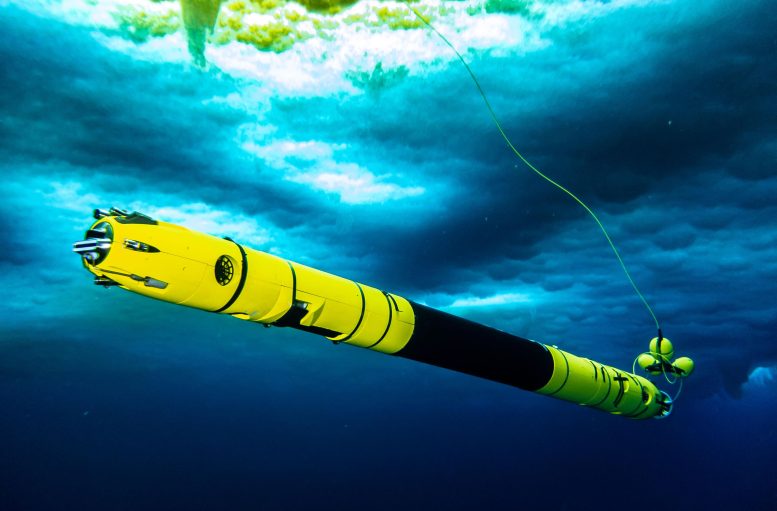Astrobiologists at Cornell University have devised a method to determine the ocean temperatures of distant celestial bodies like Enceladus and Europa by studying the thickness of their ice shells. Credit: SciTechDaily.com
A novel method by Cornell scientists uses ice shell thickness to predict ocean temperatures on distant moons, offering new insights into their potential for life.
Cornell University astrobiologists have devised a novel way to determine ocean temperatures of distant worlds based on the thickness of their ice shells, effectively conducting oceanography from space.
Available data showing ice thickness variation already allows a prediction for the upper ocean of Enceladus, a moon of Saturn, and a NASA mission’s planned orbital survey of Europa’s ice shell should do the same for the much larger Jovian moon, enhancing the mission’s findings about whether it could support life.
Ice Pumping and Its Cosmic Implications
The researchers propose that a process called “ice pumping,” which they’ve observed below Antarctic ice shelves, likely shapes the undersides of Europa’s and Enceladus’ ice shells, but should also operate at Ganymede and Titan, large moons of Jupiter and Saturn, respectively. They show that temperature ranges where the ice and ocean interact – important regions where ingredients for life may be exchanged – can be calculated based on an ice shell’s slope and changes in water’s freezing point at different pressures and salinities.
“If we can measure the thickness variation across these ice shells, then we’re able to get temperature constraints on the oceans, which there’s really no other way yet to do without drilling into them,” said Britney Schmidt, associate professor of astronomy and of earth and atmospheric sciences. “This gives us another tool for trying to figure out how these oceans work. And the big question is, are things living there, or could they?”
Along with current and former members of Planetary Habitability and Technology Lab, Schmidt is a co-author of “Ice-Ocean Interactions on Ocean Worlds Influence Ice Shell Topography,” published in the Journal of Geophysical Research: Planets.

The icefin robot under the ice near McMurdo research station, operated by the US Antarctic Program. Credit: Rob Robbins USAP
Interdisciplinary Insights and Future Explorations
In 2019, using the remotely operated Icefin robot, Schmidt’s team observed ice pumping inside a crevasse beneath Antarctica’s Ross Ice Shelf.
The researchers mapped ranges of potential shell thickness, pressure, and salinity for ocean worlds with varying gravity and concluded that ice pumping would occur in the most probable scenarios, though not in all. They found that ice-ocean interactions on Europa may be similar to those observed beneath the Ross Ice Shelf – evidence that such regions may be some of the most Earth-like on alien worlds, said Justin Lawrence, a visiting scholar at the Cornell Center for Astrophysics and Planetary Science and a program manager at Honeybee Robotics.
NASA’s Cassini probe generated data sufficient to predict a temperature range for Enceladus’ ocean, based on the slope of its ice shell from poles to equator: minus 1.095 degrees to minus 1.272 degrees Celsius. Knowing temperatures informs understanding of how heat flows through oceans and how they circulate, affecting habitability.
The researchers expect ice pumping to be weak at Enceladus, a small moon (the width of Arizona) with dramatic topography, while at larger Europa – nearly the size of Earth’s moon – they predict it acts quickly to smooth and flatten the ice shell’s base.
Schmidt said the work demonstrates how research investigating climate change on Earth can also benefit planetary science, a reason NASA has supported Icefin’s development.
“There’s a connection between the shape of the ice shell and the temperature in the ocean,” Schmidt said. “This is a new way to get more insight from ice shell measurements that we hope to be able to get for Europa and other worlds.”
Reference: “Ice-Ocean Interactions on Ocean Worlds Influence Ice Shell Topography” by J. D. Lawrence, B. E. Schmidt, J. J. Buffo, P. M. Washam, C. Chivers and S. Miller, 13 February 2024, Journal of Geophysical Research: Planets.
DOI: 10.1029/2023JE008036
The research was supported by NASA’s Future Investigators in NASA Earth and Space Science and Technology (FINESST) program and the National Science Foundation.





